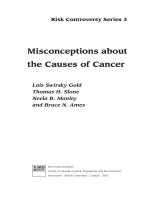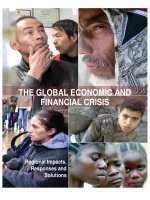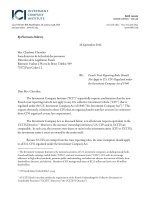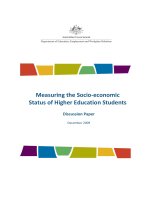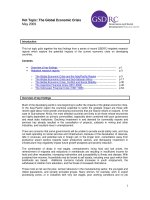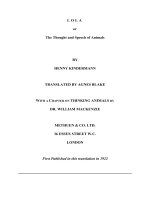THE GLOBAL ECONOMIC COST OF CANCER pptx
Bạn đang xem bản rút gọn của tài liệu. Xem và tải ngay bản đầy đủ của tài liệu tại đây (408.58 KB, 14 trang )
THE GLOBAL
ECONOMIC COST
OF CANCER
Cancer is taking an enormous human toll around the world and is a growing
threat in low- to middle-income countries. And little has been known about
what that toll means in dollars, until now.
The American Cancer Society and LIVESTRONG joined together to conduct
a landmark study of the economic cost of all causes of death globally,
including cancer and other noncommunicable and communicable diseases.
Cancer is the world’s leading cause of death, followed by heart disease
and stroke. This critical new joint report, authored by Dr. Rijo John and Dr.
Hana Ross of the American Cancer Society, shows that cancer also has the
greatest economic impact from premature death and disability of all causes
of death worldwide. This data provides compelling evidence that balancing
the world’s global health agenda to address cancer will not only save
millions of lives, but also billions of dollars.
1
ABOUT THE GLOBAL ECONOMIC
COST OF CANCER REPORT
THE OVERALL ECONOMIC IMPACT
For the first time, research has shown that cancer has the most devastating
economic impact of any cause of death in the world.
The total economic impact of premature death and disability from cancer
worldwide was $895 billion in 2008. This figure represents 1.5 percent of
the world’s gross domestic product (GDP). This economic toll from cancer
is nearly 19 percent higher than heart disease, the second leading cause
of economic loss ($895 billion and $753 billion, respectively). This analysis
did not include direct medical costs, which would further increase the total
economic cost caused by cancer.
The lost years of life and productivity caused by cancer represent the single
largest drain on the global economy, compared to other causes of death,
including HIV/AIDS and other infectious diseases.
The first-of-its-kind analysis of the global economic impact of cancer is
contained in this report released by the American Cancer Society and
LIVESTRONG. The landmark economic study comes at a time when cancer
and other noncommunicable diseases are gaining more attention from
health ministers around the world and in the wake of the U.N. General
Assembly call for a high-level meeting on the issue in September 2011.
Death and disability from lung cancer, colon/rectal cancer, and breast
cancer account for the largest economic costs on a global scale. In low-
income countries, cancers of the mouth and throat, cervix, and breast have
the greatest impact. While this report focuses on the economic burden of
cancer globally, the burden on individuals and families is also profound,
especially in low- and middle-income countries where the loss of income
due to sickness or death can quickly undermine family finances. Targeted
prevention and treatment strategies aimed at these and other preventable
forms of cancer not only could save lives, but also improve economic
development prospects in many nations.
These and other findings in the report are more important than ever in light
of the fact that cancer is projected to become the leading cause of death
2
EXECUTIVE SUMMARY
worldwide, followed by heart disease and stroke. There were an estimated
7.6 million deaths from cancer in 2008. Sixty percent of those deaths and
more than half of the estimated 12.4 million cases of cancer diagnosed each
year take place in developing countries, yet little study has been focused on
the economic impact of the disease in countries where preventable forms of
cancer are taking a disproportionate toll.
Although the exact economic impact of cancer and other noncommunicable
diseases is not completely understood, there is little doubt that the impact
is immense. The research, based on death and disability from 17 forms
of cancer among 188 member nations of the World Health Organization
(WHO), confirms this conclusion. The $895 billion removed from the
economy amounts to 1.5 percent of the total global GDP.
DISTRIBUTION OF ECONOMIC IMPACT
As expected, the impact is not evenly distributed among the nations.
For instance, while the United States has the highest economic loss from
cancer in absolute dollars, the disease costs the country 1.73 percent of its
GDP. But cancer in Hungary, with its much smaller population and domestic
economy, takes an economic toll that is 3.05 percent of its GDP. Twenty-five
nations are losing more than 2 percent of their GDP to deaths and disability
caused by cancer. Nearly half of all countries studied are losing more than 1
percent of GDP to the disease. The WHO and global health experts believe
that significant costs from cancer could be mitigated by targeted, cost-
effective interventions that have worked in more affluent nations.
The study further confirms that the “silent pandemic” of cancer is spreading
through low- and middle-income countries. Without a substantive global
response, it could overwhelm public health systems, threaten social structures,
and undermine economic development efforts.
Cancers of the lung, bronchus, and trachea by far account for the largest
drain – nearly $180 billion – on the global economy. That’s not surprising,
given that smokers die an average of 15 years earlier than nonsmokers. If
current trends continue, tobacco will kill seven million people annually by
2020 and eight million per year by 2030, with more than 80 percent of the
deaths taking place in low- to middle-income countries. One-third of those
deaths are the result of cancers.
3
Unfortunately, tobacco kills thousands of nonsmokers every year as well –
among them an estimated 200,000 who are exposed to secondhand smoke
in the workplace.
Because the death and disability toll from lung cancer remains high across
income levels of nearly all nations, efforts like the WHO Framework
Convention on Tobacco Control (FCTC) could have a significant impact in
reducing economic losses. The WHO FCTC is an international treaty signed
by 168 countries to regulate the sale and marketing of tobacco products.
Success at tobacco control could pay other dividends in both public health
and economic development, the research concludes. Intervention programs
targeted to reduce tobacco use could also produce favorable results in
controlling cardiovascular and respiratory diseases.
Another finding in the report illustrates the heavy burden individuals in
less affluent nations must bear due to the lack of awareness and effective
interventions for some types of cancer. Despite the fact that most cases of
cervical cancer can be prevented or treated effectively, 274,000 women die
from the disease yearly. Approximately 241,000 of these deaths are among
women in low- and middle-income nations.
The economic impact of cancer of the cervix in low-income countries is
equally disproportionate and compelling, the analysis shows.
Among nations classified by the World Bank as low income, cervical cancer
accounts for more than 10 percent of the economic loss, second only to
mouth and throat cancers.
Unfortunately, the majority of women in low-income countries do not have
access to care that can prevent the onset of cervical cancer or detect it
early enough for a cure. As a result, many women are diagnosed too late to
benefit from lifesaving treatment. In contrast, a large proportion of women
living in high-income countries have benefited from routine screening and
treatment modalities for more than 50 years, and, as a result, cervical cancer
rates have dropped dramatically in those nations.
4
Young women in developed countries have also gained access to a vaccine
against the most common strains of human papillomavirus (HPV). This
potentially lifesaving tool will further strengthen their chances of leading
longer, healthier lives. But to date, the price of this vaccine is out of reach to
individuals in all but the wealthiest nations.
These findings should give added emphasis to the WHO’s initiatives to expand
cervical cancer prevention and control programs in developing nations.
IMPLICATIONS FOR BALANCING THE
GLOBAL HEALTH AGENDA
In recent years, the global health agenda had been dominated by traditional
public health issues such as HIV/AIDS, TB, and malaria; maternal and
child health; and malnutrition. These efforts are noble and should not be
diminished because of the threat these serious conditions continue to pose
to individuals and public health.
But, as more data like this is accumulated, we must press for additional
resources to combat cancer and to build a more balanced global health
portfolio that includes health promotion, policy reform, prevention, and
treatment of all noncommunicable diseases. In addition, strengthening health
systems will make efforts to reduce the burden of both communicable and
noncommunicable diseases more effective and sustainable.
We are all aware of the profound suffering and loss cancer causes
among individuals and families. With the publication of this report, we
are beginning to comprehend the toll the disease is taking on economic
productivity worldwide. If we act quickly, we have the opportunity to avert
needless deaths and suffering from cancer and to reduce its devastating
economic impact.
5
• The total economic impact of premature death and disability from cancer
worldwide was $895 billion in 2008. This figure, which does not include
direct costs of treating cancer, represents 1.5 percent of the world’s GDP.
• Using a formula accepted by public health researchers and economists
to measure the global burden of disease, there were 83 million years of
“healthy life” lost due to death and disability from cancer in 2008.
• The top three cancers that account for the highest number of healthy life
years lost were lung cancer (15.5 percent), stomach cancer (9.6 percent),
and liver cancer (8.6 percent).
• The top three cancers that caused the most economic impact globally
were lung cancer ($188 billion), colon/rectum cancer ($99 billion), and
breast cancer ($88 billion).
• Cancer causes the highest economic loss of all of the 15 leading causes
of death worldwide. The economic toll from cancer is nearly 20 percent
higher than heart disease, the second leading cause of economic loss
($895 billion and $753 billion, respectively).
6
HIGHLIGHTS FROM THE REPORT
Previous studies on the economic impact of diseases have been limited to
a handful of high-income countries. There have been very few attempts
to quantify the economic loss due to cancer or other diseases on a global
basis. This study amounts to the first substantive effort to do so.
For this study, researchers used computations taken from the WHO that
combine the death and disability dimensions of illness into a single summary,
called a DALY (disability-adjusted life year), for 17 types of cancer, as well as
the 15 leading causes of death. DALYs are a measure to describe the overall
burden of diseases.
Simply put, a DALY is the sum of years of life lost by a patient due to premature
death, as well as the years a patient lived with a disability resulting from a
disease. The use of DALYs is not without criticism – the disability weights
associated with some diseases can highly influence the score for certain
diseases; the WHO and other global health groups employ the method.
The next step was to estimate the economic value of a year of healthy life
in order to measure the overall impact of healthy lives lost to death and
disability. This study uses a method employed by the WHO Commission
on Macroeconomics and Health, which makes the assumption that each
disability-adjusted life year can be valued at one year of the per-capita GDP
for the nation being studied. Since the economic value of DALYs in this
study would obviously be affected by the size of the country’s per-capita
GDP, the researchers decided to present these values as a percentage of
each country’s GDP. By using this measurement, comparisons between each
country can be more meaningful. DALYs are widely used by the WHO and
other groups to calculate the disease burden and are available for most
countries in the world.
In addition, the researchers classified all countries they studied into one
of four income categories as recognized by the World Bank’s World
Development Report of 2004. This adjustment allows for a better
understanding and comparison for which cancers had the highest economic
impact for countries in each of the four classifications: high-income
countries, upper middle-income countries, lower middle-income countries
7
HOW THE STUDY WAS CONDUCTED
and low-income countries. The sum of the economic losses across these
four groups was used to arrive at the world total, and it is expressed in
2008 U.S. dollars.
All data on DALYs and death rates was obtained from the WHO Global
Burden of Disease estimates for 2004 for member countries and 2008 for
the four aggregated country income groups.
8
0 200 400 600 800 1000
Cancer
Heart diseases
Cerebrovascular disease
Diabetes mellitus
Road traffic accidents
Chronic obstructive pulmonary disease
HIV/AIDS
Perinatal conditions
Suicides
Lower respiritory infections
Cirrhosis of the liver
Diarrhoeal diseases
Tuberculosis
Malaria
Measles
Economic Loss From the Top 15 Global Causes of Death
895.2
753.2
204.4
298.2
204.4
203.1
193.3
192.8
140.8
125.8
92.8
70.1
45.4
24.8
8.1
Economic Value of DALYs
†
Lost (US$ billion) in 2008
†
Disability-adjusted Life Year
9
0 1000 2000 3000 4000 5000 6000
Trachea/bronchus/lung
Colon/rectum
Breast
Trachea/bronchus/lung
Colon/rectum
Breast
Trachea/bronchus/lung
Stomach
Liver
Mouth and oropharynx
Cervix uteri
Breast
Top 3 Cancer Sites for Country-income Groups by DALYs Lost
3754.7
2117.9
1828.9
1433.7
854.8
846.1
5902.0
4792.1
4589.2
2252.4
2191.0
1899.3
Estimated DALYs
†
(’000) Lost in 2008
†
Disability-adjusted Life Year
High
Income
Upper Middle
Income
Lower Middle
Income
Low
Income
10
0 20 40 60 80 100 120 140 160
Trachea/bronchus/lung
Colon/rectum
Breast
Trachea/bronchus/lung
Colon/rectum
Breast
Trachea/bronchus/lung
Stomach
Liver
Mouth and oropharynx
Cervix uteri
Breast
Top 3 Cancer Sites for Country-income Groups by
Economic Value Lost
151.8
85.6
73.9
12.8
10.2
9.8
12.6
10.2
9.8
1.3
1.3
1.1
Estimated Economic Value of DALYs
†
Lost (US$ billion) in 2008
†
Disability-adjusted Life Year
High
Income
Upper Middle
Income
Lower Middle
Income
Low
Income
Distribution of World Population by Country-income Group
High Income
Upper Middle
Income
Low and Lower
Middle Income
76.4%
8.8%
14.8%
≤ US$3,255
per-capita GDP
©2010, American Cancer Society, Inc.
No.005444



